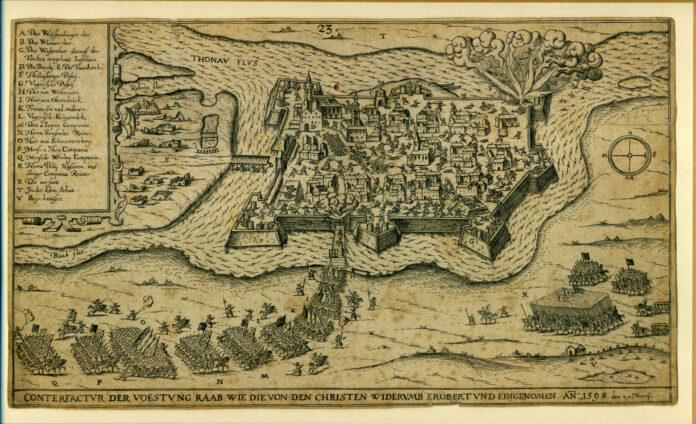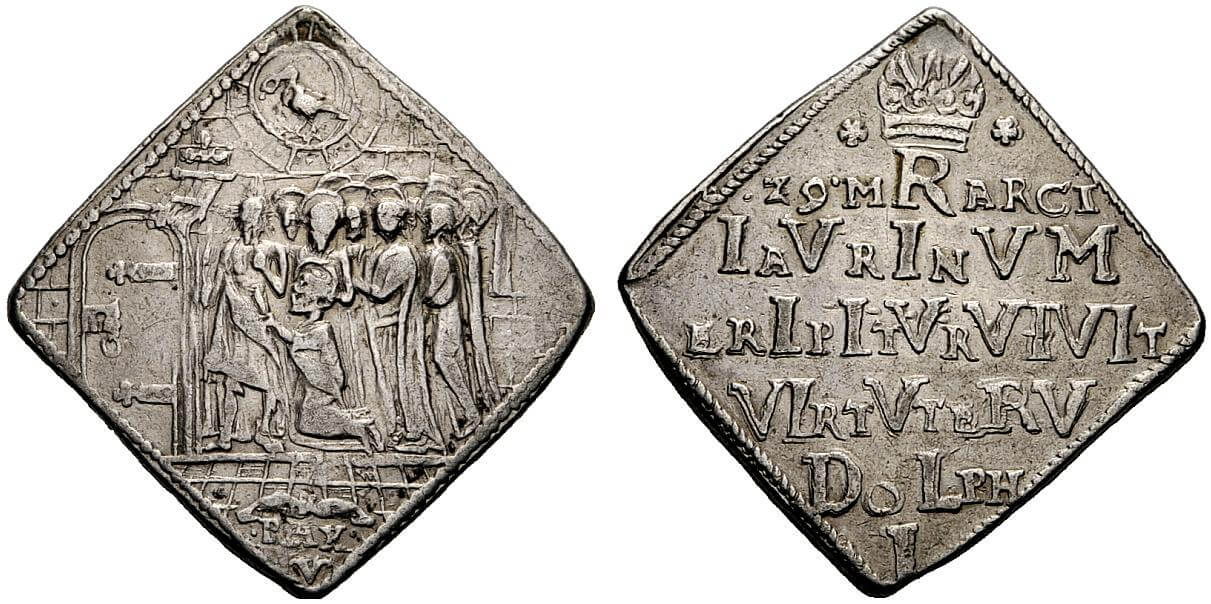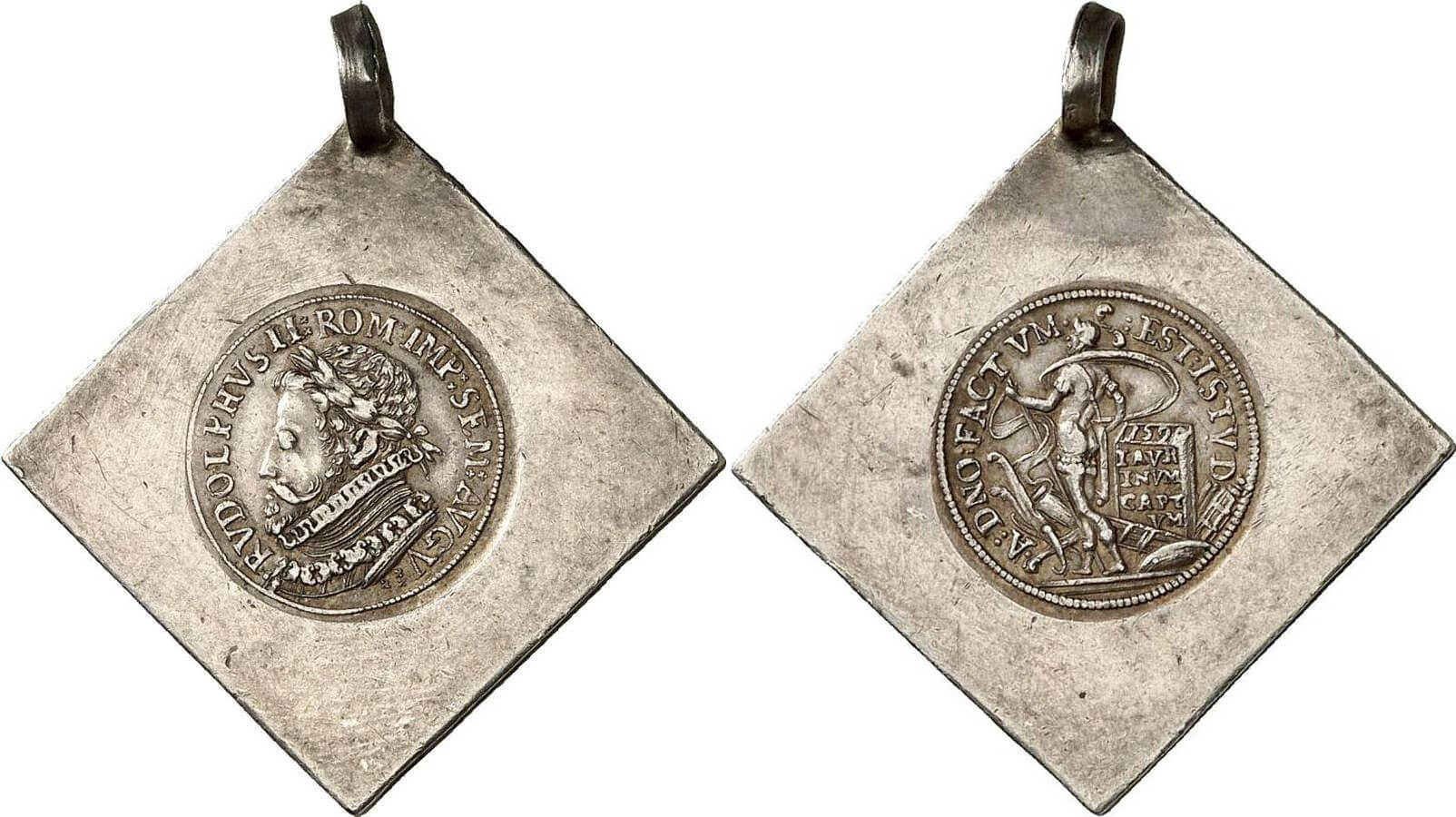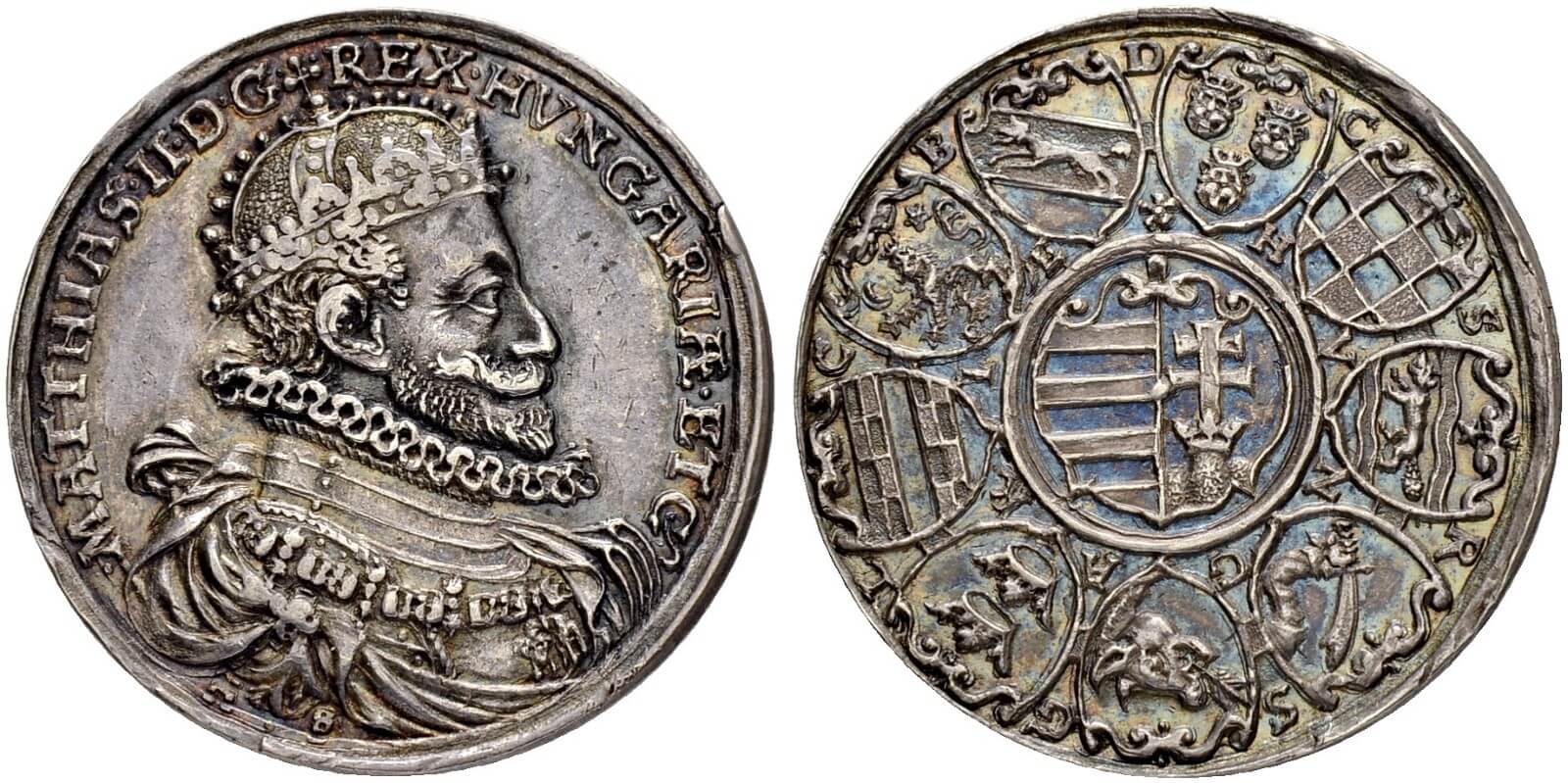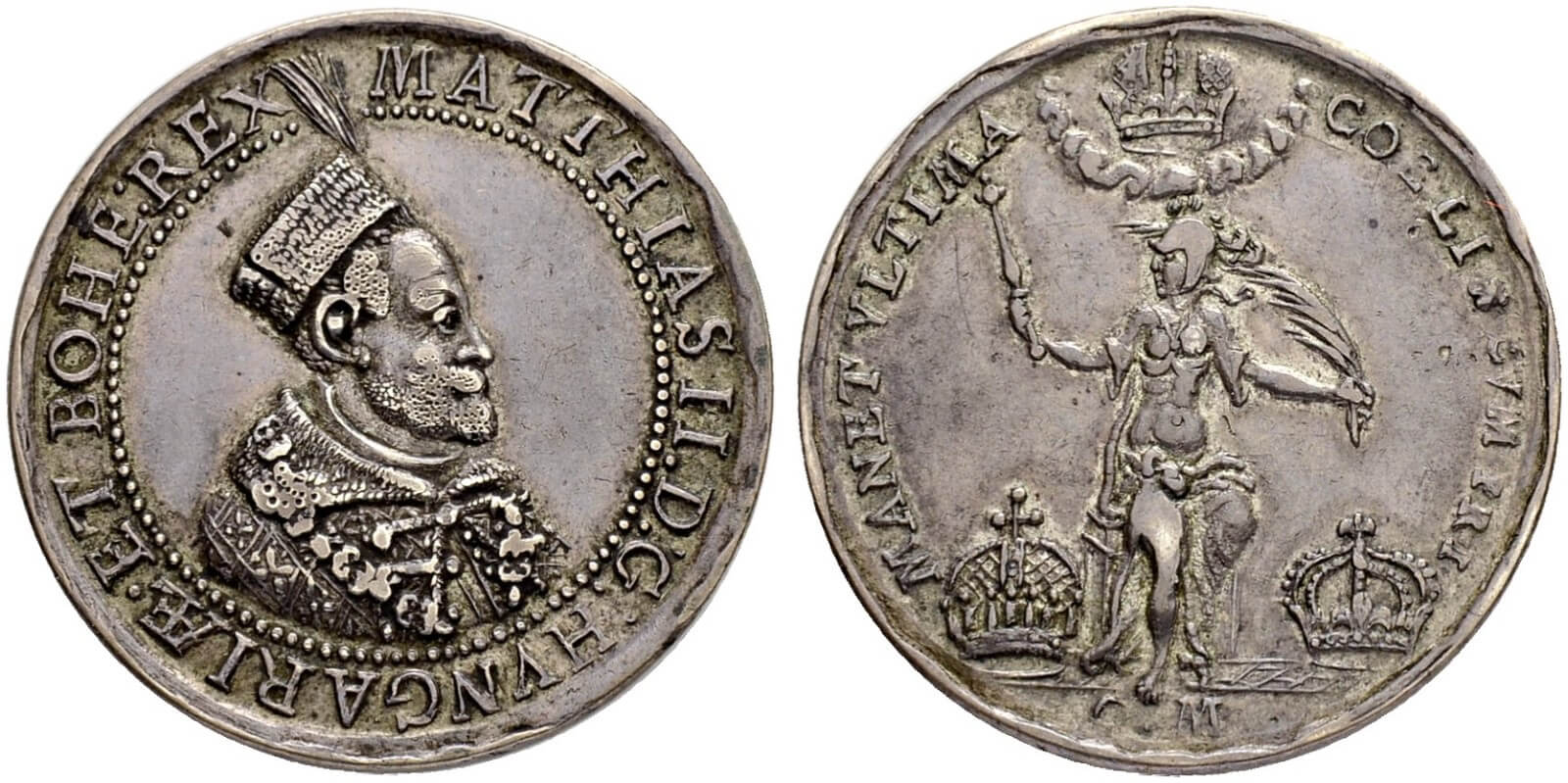As a result of the Turkish war, Rudolf saw his God-given omnipotence tarnished. Thus, the emperor sought refuge in his art collection, for which he always had money. However, this didn’t help him against his ambitious brother Matthias.
The Conquest of Raab
For Rudolf, the Turkish war was kind of Armageddon – an eschatological final battle between Christians in the service of God and evil forces personified by the Ottomans. As emperor, Rudolf considered it his duty to win. Unfortunately, the war was actually more of a manoeuvring of constantly underpaid troops opposing the looting carried out by the Ottomans. But then the fortress of Raab (Hung.: Győr, Lat.: Iauriunum) was reconquered, and Rudolf was sure that this event marked a partial victory against the evil forces.
Under the command of Adolf von Schwarzenberg and Niklas Pálffy, the city gate was blown up with a petard and the fortress was taken on 29 March 1598. The man who had built the petard received a gratuity payment of 300 reichstalers, the commanders got much more.
The victory was celebrated by means of all media of the time. We know of splendid paintings, which were on display in Rudolf’s castles and which were sent to friendly rulers. An abundance of single-leaf prints addressed to citizens and landed gentry was produced. Rudolf commanded the Austrian municipalities to erect “Raaber Kreuze” [Raab crosses] bearing an inscription thanking God for the re-conquest of Raab. In this way, the rural population also got to know about the event.
And, of course, Rudolf ordered an abundance of medals. Some pieces almost equate the Christian army outside Raab with Christ. The inscription of a klippe worth two ducats refers to the blowing up of the city gate. Christ is even capable of walking through closed doors, it says. And in fact, we see Christ standing in front of a door: he shows the way to the community who’s invoking him.
Another medal presents the fortress of Raab from a bird’s eye view. Pay attention to the drawbridge and the gate. There you can see a cloud of smoke and dust reminiscent of the explosion.
Another taler klippe features war god Mars and bears the legend “Von Gott wurde dies vollbracht” (= This was accomplished by God). Mars is wearing a curious circle around his neck. It isn’t a shield but the ouroboros with whom we’re already familiar as a sign of the happy era that is heralded by the victory of Raab.
The Dream of Victory and the Reality
Rudolf believed in 1598 that he (= the army) had been the instrument of the heavens in the war against hell. For him, it was impossible what his brothers and advisors had realised long ago: they couldn’t win the war against the Ottomans. It harmed both empires, thus, they needed peace. This peace went down in history as the Peace of Zsitvatorok. The treaty was adopted on 11 November 1606 and stipulated a one-off payment of 200,000 guldens to the Ottoman sultan. This finally put an end to the Habsburgs’ tributes to the Sublime Porte, which had been euphemistically called gifts until then. For the first time, the Ottoman sultan recognized the equality of status of the Habsburg ruler. Apart from that, the borders that had existed before the Turkish war were re-established with a few exceptions. De facto, this treaty was a diplomatic victory of the Habsburgs. Rudolf was desperate, though. For him, the conditions went against everything that an emperor stood for.

A Collection as a Political Means
What the sacrosanct office of an emperor meant to Rudolf is wonderfully illustrated by his art collections. In these collections, he gathered the world around him. The entire universe known back then was represented by the precious objects that Rudolf had ordered from all over the world. Despite lack of funding, he simply needed to gather the most beautiful, the rarest, the best objects around him. For artists and their work, for ancient pieces and rare coins, for ingenious automatons and the finest cut glass, for precious natural produces and relics – there was always enough money for all of this.
Thus the emperor’s court became the centre of art trade, which was already very active around 1600. The key figure in this context was the Italian art dealer and numismatist Jacopo Strada (1507–1588) and his son Ottavio (1550–1607), whom Rudolf brought to the court in Prague immediately after ascending the throne. His father had trained as an art agent of the Fugger family. As of 1556, at the latest, he also served the Habsburgs in this function. How close the connection of the emperor and this originally middle-class family was is illustrated by the fact that Ottavio’s daughter Katharina became the emperor’s mistress, of whom Rudolf had six children – all of them were obviously not of the same rank as his legitimate children and were therefore unsuitable with regard to the succession to the throne.
The main reason why Rudolf used to hide in the rooms of his collection towards the end of his life with increasing frequency is that in his collection he seemed to be the almighty emperor that he wanted to be. All these treasures from all over the known world seemed to reflect his all-embracing dignity, a dignity that he was in danger of losing in real life.

Fraternal Quarrel in the House of Habsburg
An occasionally melancholy emperor who refused to marry and to produce offspring and an extremely ambitious brother: this combination was more than explosive. It worsened the symptoms of Rudolf’s disease. His confessor Johannes Pistorius, who is probably the person who knew him best of all his contemporaries, wrote about him: “He is not possessed, as some people think, but suffers from melancholy, which has caused far too deep wounds over the course of a long period of time.”
Rudolf didn’t have a relationship with his brothers that would have made him consider them to be trustworthy enough to voluntarily hand over part of his power to them. He was the almighty emperor! Period. The extremely ambitious Matthias, who thought that he had great prospects regarding the succession since the second eldest brother Ernest died in 1595, no longer wanted to accept the existing situation. He was convinced that the danger of Rudolf appointing someone else as his successor at the last second was too high. (As I said, the principle of primogeniture was still quite controversial around 1600.) If we also consider the fact that the religious situation started to get worse around 1600, there was no longer room for a liberal emperor. The religious hardliners who gathered around Matthias urged confrontation.
So when the emperor suffered a severe health crisis in 1599 – perhaps caused by his brothers’ pressure to finally resolve the succession issue – Matthias, Maximilian and Ferdinand met in Schottwien at the Semmering pass. There they concluded their first treaty aimed at enforcing an order of succession against the emperor.
In a joint document of 25 April 1606, the brothers declared the emperor to be mentally ill and openly expressed their will to degrade him. In 1608, Matthias had gathered an army and marched on Prague. The Bohemian estates defended their emperor and thus Matthias had to share the power with Rudolf in the treaty of Libeň. Rudolf kept Bohemia, Silesia and Lusatia. Matthias took Hungary, Austria and Moravia.
By the way, not all subjects were happy about that. Especially the Protestants were afraid of a recatholisation, which seemed to be inevitable if Matthias took the power. Only when Matthias guaranteed their religious freedom they accepted him as their new ruler.

An Army of Mercenaries
In order to protect himself against another attack of his brother, Rudolf II hired a group of mercenaries known as the “Passauer Kriegsvolk” (the Passau war people). It had originally been set up by the prince-bishop of Passau in order to be used in the War of the Jülich Succession. Prince-bishop Leopold of Austria-Tirol, who was married to Claudia de’ Medici, was a relative of Rudolf and had gained his favour. Legend has it that Rudolf seriously thought about making him his successor in order to exclude hated Matthias from power.
Under the command of Leopold, the mercenaries tried to “secure” Prague. They occupied Malá Strana. The old town remained under control of the citizens and was defended successfully. The city council knew about the cruel attacks committed by the mercenaries of the conquered city of České Budějovice. Since neither Leopold nor the emperor had the money to pay them, the mercenaries rewarded themselves in other ways.
Leopold had to withdraw und Matthias occupied the city with his troops in March 1611. On 23 Mai of the same year, he had himself crowned king in Prague.
A Lonely Emperor Surrounded by Art Treasures
As a result, the emperor was left with only the Castle District, where he resided as emperor surrounded by his art collection. And even this office was in danger. By means of the coronation as King of Bohemia, Matthias had become elector and in this function he had the right to convene a Diet of the Electors. At such a diet, the dismissal of Rudolf and the election of Matthias was to be decided. Due to the early death of Rudolf II, Matthias didn’t have to take those measures.
Had the brothers been right to urge the removal of the idle emperor? The succession issue was certainly of essential importance. However, one also has to admit that, despite his melancholy, Rudolf II had managed to maintain peace between Protestants and Catholics, while Matthias left his successors with one of the worst wars in human history: the Thirty Years’ War caused by the defenestration of Prague. The Bohemians threw the emperor’s envoys out of the window because Matthias had violated the freedom of religion granted by Rudolf II.
Here you can find all episodes of this three-part article.



